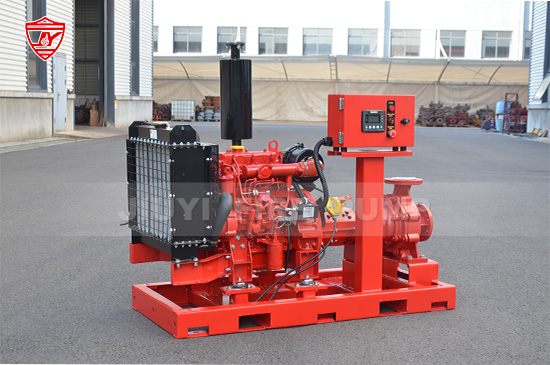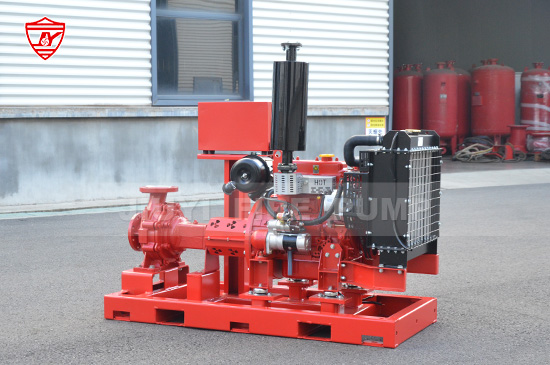A diesel engine fire pump is a vital component in fire protection systems. Its reliability can be the difference between containing a fire quickly and facing severe property loss. However, even the most high-quality diesel fire pumps can face starting failures due to various mechanical, electrical, or operational issues. Understanding how to troubleshoot these problems effectively ensures system readiness, compliance with NFPA 20 standards, and ultimately, the safety of people and property.
This article provides a comprehensive guide to diagnosing and fixing diesel fire pump starting failures, focusing on the most common causes, inspection procedures, and preventive measures recommended by fire safety professionals.

Before troubleshooting, it’s important to understand how a diesel fire pump is designed to start. Typically, the sequence includes:
Detection of low pressure in the system.
Activation of the control panel.
Starter motor engages the diesel engine.
The engine cranks and reaches running speed.
The pump begins delivering water at the required pressure.
If the pump fails to start at any of these stages, the issue can usually be traced back to either the control circuit, the battery system, fuel delivery, or the engine itself.
The control panel is the “brain” of the fire pump system. Any disruption here can prevent the diesel engine from starting.
Common issues include:
Faulty start signal relay or loose connections.
Malfunctioning pressure switches or sensors.
Defective automatic/manual selector switches.
Blown fuses or tripped circuit breakers.
Troubleshooting steps:
Ensure the control panel receives stable power.
Check the auto/manual switch and ensure it’s in automatic mode.
Inspect wiring terminals for corrosion or looseness.
Replace any damaged relays or fuses.
Confirm that the start signal from the pressure switch is reaching the control panel.
If everything appears normal in the control circuit but the engine still doesn’t crank, the problem may lie with the batteries or the starter motor.
Weak or discharged batteries are among the most common causes of diesel fire pump starting failure. According to NFPA 20, diesel fire pump systems must have two separate batteries and chargers to ensure redundancy.
Typical battery-related problems:
Low battery voltage due to poor maintenance.
Loose or corroded battery terminals.
Faulty battery charger.
Sulfation or internal damage to battery cells.
Troubleshooting steps:
Check battery voltage (should be within manufacturer’s recommended range, usually 24V).
Inspect terminals and cables for corrosion or looseness.
Confirm chargers are operational and providing correct voltage output.
Load-test the batteries to ensure they can deliver the required starting current.
Replace batteries that fail to hold charge or show significant voltage drop under load.
Regular monthly testing and charger maintenance are essential to prevent these issues.
If the engine cranks but does not start, fuel system issues are likely. Diesel engines depend on consistent and clean fuel delivery.
Possible fuel system problems:
Empty or contaminated fuel tank.
Clogged fuel filters.
Air trapped in fuel lines.
Faulty fuel pump or injector system.
Troubleshooting steps:
Check the fuel level and ensure the diesel is clean and free of water or sediment.
Drain and replace old or contaminated fuel.
Inspect fuel filters and replace if clogged.
Bleed the fuel lines to remove trapped air.
Test the fuel pump operation and injector performance.
NFPA 20 recommends keeping fuel tanks at least two-thirds full and performing periodic fuel quality inspections to avoid microbial growth and sludge formation.
Restricted air intake or a blocked exhaust can prevent proper combustion, making it difficult for the diesel engine to start.
Inspection checklist:
Remove and inspect air filters for dust, oil, or debris accumulation.
Ensure intake valves are clear and unobstructed.
Check the exhaust pipe for carbon buildup or blockages.
Inspect turbochargers (if applicable) for oil leaks or mechanical damage.
Keeping the air intake and exhaust systems clean improves engine efficiency and reliability.
If the engine tries to start but shuts down shortly after, overheating or lubrication issues could be the cause.
Troubleshooting points:
Check coolant level in the radiator and expansion tank.
Inspect coolant hoses for leaks or cracks.
Ensure the coolant temperature sensor is working correctly.
Verify engine oil level and condition—dirty or low oil can trigger safety shutdowns.
Performing regular oil changes and coolant checks ensures the engine remains in optimal operating condition and prevents unplanned failures.
When the engine doesn’t crank at all, even with proper battery voltage, the problem may be mechanical or electrical within the starter assembly.
Typical issues include:
Faulty starter motor or solenoid.
Damaged starter wiring or ground connections.
Stuck pinion gear or worn flywheel teeth.
Troubleshooting steps:
Test voltage at the starter terminals while cranking.
Check for loose or burnt wiring.
Tap the starter lightly to release a stuck solenoid (temporary measure).
Replace the starter motor if it shows no response under proper voltage.
Diesel fire pumps are equipped with safety shutdown devices for parameters like low oil pressure, high water temperature, or overspeed. While these are critical for protection, faulty sensors can trigger false shutdowns, preventing the pump from starting.
Troubleshooting steps:
Check all safety shutdown circuits for normal readings.
Bypass (for testing only) suspicious sensors to verify if they are causing the issue.
Replace faulty temperature or pressure switches immediately.
Always return the system to full operational safety mode after testing—never leave a fire pump with safety circuits bypassed.
NFPA 20 provides clear guidelines for weekly and monthly testing of diesel fire pumps to ensure readiness. Regular testing is not only a compliance requirement but also the best prevention against starting failures.
Recommended testing includes:
Weekly automatic start test: Verify engine starts within 10 seconds and runs smoothly.
Monthly manual test: Run the pump under load to ensure all systems operate correctly.
Annual inspection: Comprehensive inspection of batteries, control panels, sensors, and fuel systems.
Keeping detailed test logs helps identify early warning signs of component wear or performance degradation.
Prevention is always more efficient than emergency repair. Establishing a proactive maintenance program ensures long-term reliability of diesel fire pumps.
Maintenance best practices:
Clean and tighten all electrical connections regularly.
Replace filters and fluids at manufacturer-recommended intervals.
Test and rotate batteries every month.
Drain water and sediment from fuel tanks quarterly.
Record all inspections, tests, and maintenance actions.
A well-documented maintenance history helps demonstrate compliance and ensures system reliability during emergencies.
If troubleshooting does not identify the root cause, or if repairs involve complex electrical or mechanical work, contact a certified fire pump technician or your fire pump manufacturer’s service department. Professional diagnostics ensure the system meets all operational and safety requirements.

Diesel fire pump starting failures can result from a variety of issues—ranging from minor electrical faults to fuel contamination or engine wear. A structured troubleshooting approach, combined with regular maintenance and compliance with NFPA 20 standards, ensures your fire pump system remains reliable when it’s needed most.
As a manufacturer of diesel engine fire pumps, we emphasize not only producing high-performance equipment but also empowering users with the knowledge to maintain it effectively. Consistent care, testing, and inspection will keep your fire pump ready to respond instantly in any emergency.